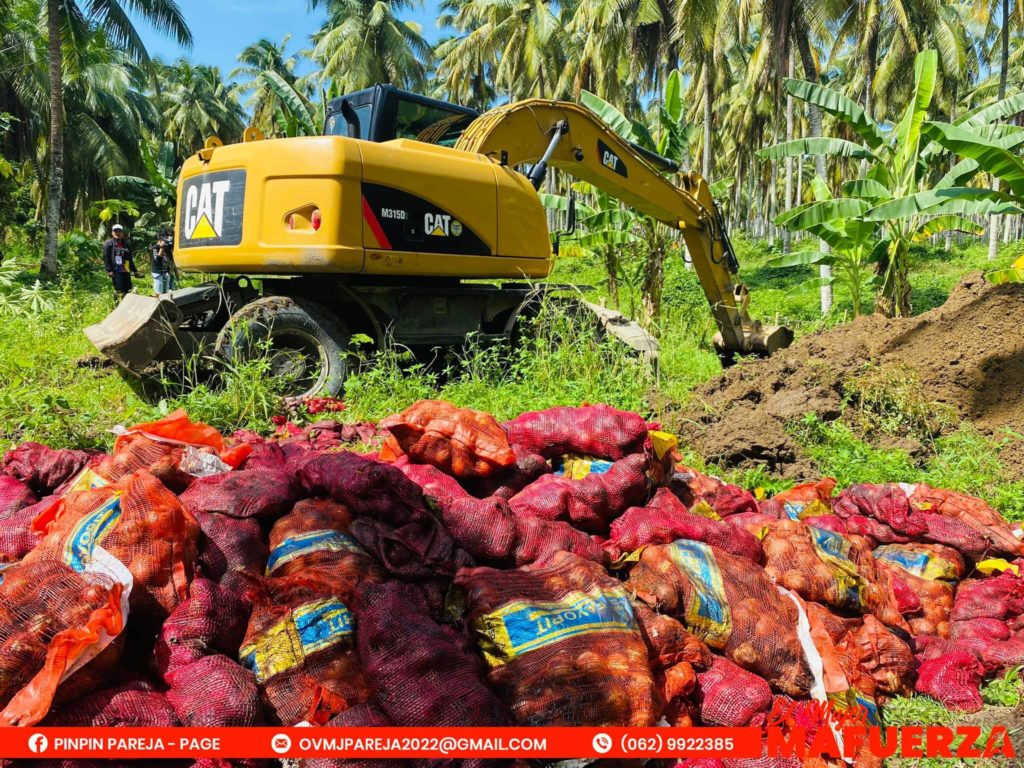70 tons of smuggled, rotting onions end up in pit

SOMETHING’S ROTTEN IN THE STATE OF AGRI | Some 70 tons of smuggled onions seized late last month and now deemed unsafe to eat are buried at a Department of Agriculture compound in San Ramon, Barangay Talisayan, Zamboanga City, on Saturday. *Photo from the Office of Vice Mayor Josephine Pareja)
More than 70,000 kilograms of smuggled onions earlier seized by authorities were destroyed in Zamboanga City due to public safety concerns.
Zamboanga City Vice Mayor Josephine Pareja expressed regret at seeing tons of red and yellow onions ending up in a pit even as consumers grapple with high prices of the commodity due to tight supply.
“It was a pity to witness expensive onions disposed of due to lack of sanitary certification,” said Pareja, who was invited to witness the destruction of the onions on Feb. 4 inside the compound of a Department of Agriculture (DA) research facility in Barangay Talisayan.
Apart from DA personnel, among those who witnessed the disposal were members of the police and the military, some local officials, and a few journalists.
The vice mayor said it was such a waste but DA regulations must be enforced.
Pareja recalled that when the batch of onions arrived at the Talisayan facility, the bulbs were already foul-smelling, indicating rot.
People living near the DA facility had complained about the odor, which apparently hastened the decision to put the crops away, she told the Inquirer.
In all, disposed of were 32,274 kilos of red onions and 39,277 kilos of the yellow variety, according to the Bureau of Plant Industry (BPI).
Can’t be donated
Floralie Yeo-Floriano, a BPI quarantine officer, explained that the onions were deemed unsafe for consumption because, being smuggled, they were not covered by phytosanitary certifications issued at the port of origin.
“There was no directive from our central office that it can be donated. So automatically, it will be destroyed because the onions are not fit for human and animal (consumption),” Yeo-Floriano explained.
“We were informed there’s no permit to ship, no laboratory test results and other necessary documents. We cannot allow it to be distributed for local consumption for fear that it may contain poisonous chemicals or elements and the bulbs may contain a disease that may affect our local onion production,” city agriculturist Carmencita Sanchez told the Inquirer.
The onions destroyed on Feb. 4 were composed of batches separately intercepted between Jan. 22 and Jan. 25 in the coastal villages of Labuan and Cawit. No one has come forward to claim ownership of the shipments.
According to the BPI, the onions originally came from India and were shipped to Malaysia before ending up in Zamboanga City via wooden-hulled boats that set off from Sabah.
A shortage in local production since last year has caused onion prices to soar as high as P700 a kilo. The recent arrival of imports and the start of the harvest season have brought retail prices down in recent days.
Gov’t intervention
To boost onion production, Malacañang said the DA, through its High Value Crops Development Program, had allotted P326.97 million for programs and projects for the industry this year.
Presidential Communications Secretary Cheloy Velicaria Garafil said P69.95 million was earmarked for onion production support services, including the provision of seeds, seedlings and other farm inputs; P3.2 million for irrigation network facilities, and P1.9 million for extension support, education, and training.
Storage sites
Garafil added that P6.49 million was also set aside for farm production-related machinery and equipment distribution; P2.36 million for production facilities, and P2.5 million for postharvest and processing equipment and machinery distribution.
The government would also build seven onion cold storage facilities in key production areas in the country worth P240.58 million as part of the intervention in the onion industry.
According to Garafil, 10,000-bag cold storage facilities would benefit onion growers’ associations in Umingan, Pangasinan, and in Aritao, Nueva Vizcaya.
She said 20,000-bag storage facilities would be set up for farmers’ associations and cooperatives in Hermosa, Bataan; Talavera, Nueva Ecija; Bongabon, Nueva Ecija, and Rizal and Sablayan, Occidental Mindoro.
Grants
A total of 10 farmers’ cooperatives and associations (FCAs) in Mimaropa (Mindoro, Marinduque, Romblon, Palawan) region have received financial grants amounting to P40 million through the DA’s Enhanced Kadiwa: Sagip Sibuyas Project, Garafil said, noting the program had so far benefited 7,800 FCA members in the region.
Under the Sagip Sibuyas Project, Garafil said, eligible FCAs would use the grant of up to P5 million for trading capital to cover the costs of procuring onions directly from farmers, hauling and delivery to markets and cold storage facilities, and storage rental.
RELATED STORIES
DA eyes P125/kilo suggested retail price for onion
LOOK: Newlywed goes viral with their onion giveaways
Disclaimer: The comments uploaded on this site do not necessarily represent or reflect the views of management and owner of Cebudailynews. We reserve the right to exclude comments that we deem to be inconsistent with our editorial standards.
